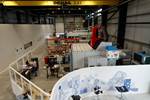Making epoxy composites recyclable by design
Connora Technologies and Adesso Advanced Materials have garnered much attention for their hardeners which make epoxy resins recyclable, marketed as Recyclamine and Cleavamine, respectively.
Connora Technologies (Hayward, CA, US) and Adesso Advanced Materials (Wu Xi, Jiangsu Province, China) have garnered much attention for their hardeners which make epoxy resins recyclable, marketed as Recyclamine and Cleavamine, respectively. Announced in a May 2014 press release, the partnership and the companies’ technologies stem from the same beginning.
Connora’s founder/CTO Stefan Pastine applied the concept of “designed-in cleavage points” from photoresist chemistry to polyamine hardeners for epoxies in 2009. Rightly engineered, he says, epoxy crosslinks can be unlinked, yielding thermoplastic molecules. Thus, the matrix and fiber reinforcement in a cured composite can both be reclaimed.
After working with Adesso in 2010, Pastine formed Connora in 2011, connecting with Rey and Desi Banatao, co-founders of Entropy Resins (Hayward, CA, US), whose desire to develop sustainable, performance composites led to formulation of Entropy’s Super Sap bio-based resins. Entropy has since served as investor and incubator for Connora, and Rey Banatao has taken the role of CEO to establish manufacturing partnerships and expand Connora’s pilot plant and R&D facilities in Hayward. Banatao says products already include infusible and compression moldable systems, a latent cure system for prepreg, filament winding or pultrusion, and is developing one for automotive HP-RTM. Connora announced in Dec. 2014 an investment from Samsung Ventures (Seoul, Korea) to advance commercialization of Recyclamine.
Related Content
-
From the CW Archives: Airbus A400M cargo door
The inaugural CW From the Archives revisits Sara Black’s 2007 story on out-of-autoclave infusion used to fabricate the massive composite upper cargo door for the Airbus A400M military airlifter.
-
COMPINNOV TP2 project promotes use of thermoplastics in aerospace
Completed in 2023, COMPINNOV TP2 explored thermoplastic composites, enhancing the understanding between prepregs and production methods to foster the potential for French aerospace innovation.
-
Flyber launches U.K. composites manufacturing site for advanced mobility applications
The startup’s design automation and composite material layup and curing technologies target lightweighting for aerospace, UAVs, eVTOL and high-performance mobility platforms.


